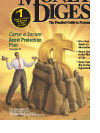Publication
Article
Will ETFs Offer You a Timely Advantage?
Author(s):
Bottom line:
Every fund manager seems to be getting intothe act of offering exchange-traded funds(ETFs). Physician-investors may be wonderingif it's time to consider them for their portfolio. You're probably better off stayingaway from them. Here's an overview of the fundsto help you make an informed decision.
OPEN-END MUTUAL FUNDS
First, take a look at the most commontype of mutual fund, an open-endmutual fund.When you invest money inone, the fund issues new shares to you,and when you sell some of your shares toget your money back, the fund redeemsthose shares. So the fund's number ofoutstanding shares is open-ended (ie, itfluctuates). Unlike stocks of a corporation,you don't buy your shares of openendmutual funds from someone elsewho owns shares in the fund.
You buy and sell shares in an openendmutual fund at the net asset value(NAV), which is calculated at the endof each trading day by valuing all theholdings of the fund and dividing thetotal value by the number of shares outstanding(before counting in that day's new investmentsand redemptions). New shares are sold andredemptions are made at the end of the day atthe same NAV.
The NAV ensures that when you sell yourshares in a fund, you effectively sell your stockshares held by the fund at that day's closingprice. And when you buy shares in the fund, youbuy proportionate shares of the fund's investmentsat the day's closing prices.
Due to the NAV's bearing on a fund's portfoliovalue, in the past, investors could buy or sell fundshares only once a day.With computerization, it isnow possible to calculate a fund's NAVminute by minute. Technically, openendmutual funds could now let youbuy and sell shares at any time of theday. But for various reasons, they don't.So you can buy or sell the regular openendmutual funds only once a day,and if you want to sell your shares in afund in the middle of the day at whatwould be a fair price at that time, youcan't. Some investors view that as aserious limitation.
EXCHANGE-TRADE ORIGINS
ETFs evolved to overcome this limitation.Their underlying structure issomewhat complex, but they're essentiallyopen-end mutual funds. You canbuy and sell them on a stock exchange,as you would trade other shares. Butunlike other shares, the price of an ETF is generallynot determined by supply and demand. Usually,its price is the NAV of the fund at that moment.
So, if you have an ETF and an open-end S&P500 fund, the key advantage of the ETF is that youcan trade it any time of the day instead of havingto wait until the day's end. If you're good at timingthe market precisely, you may be able to takeadvantage of that talent and improve your investmentresults by investing through ETFs.
A second advantage is that most ETFs—allof them are index funds—have very low expenseratios, around 0.1%. The expense ratio of thebest open-end index funds is about 0.2%, and ifyou aren't careful, you may be purchasing indexfunds with expense ratios of 0.5% or higher.However, ETFs require a brokerage commission,which should be considered in making theeconomic comparison.
NEW FUNDS' DOWNERS
So what's the downside of ETFs? What istouted as the key advantage of ETFs is also theirkey disadvantage. No one can time the marketprecisely. Anyone who tries generally gets itwrong by months or years, not just by minutes orhours. The fact that you have to wait until theend of the day to buy or sell regular mutual fundsis hardly a major disadvantage.
The ability to trade ETFs any time of the dayis likely to encourage investors to trade frequently.Worst of all, if you own ETFs, you're morelikely to sell out in a market panic than youwould if you own regular mutual funds. What'smore, if you sell ETFs in the middle of a panic,you may not get the fund's NAV at all.You mayget a much worse price, because at that point theprice may be determined by supply and demand.
You're better off staying with the old andstodgy regular open-end mutual funds. Justmake sure that you're investing only in the onesthat have very low expense ratios.
Chandan Sengupta,author of The OnlyProven Road to InvestmentSuccess (JohnWiley; 2002), currentlyteaches finance at theFordham UniversityGraduate School ofBusiness and consultswith individuals onfinancial planning andinvestment management.He welcomesquestions or commentsat chandansen@aol.com.
